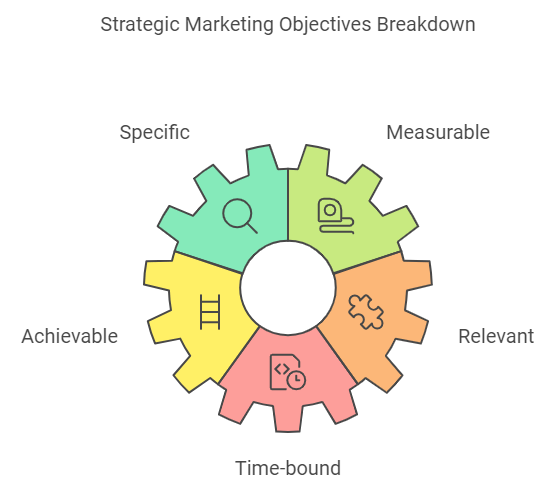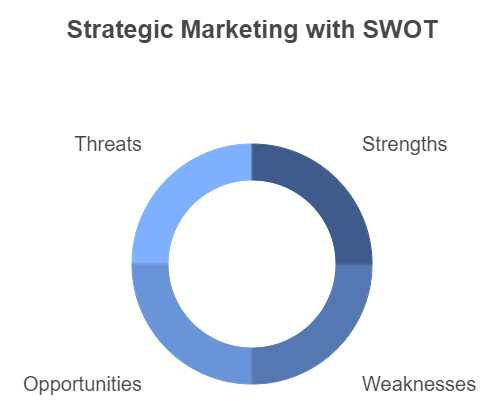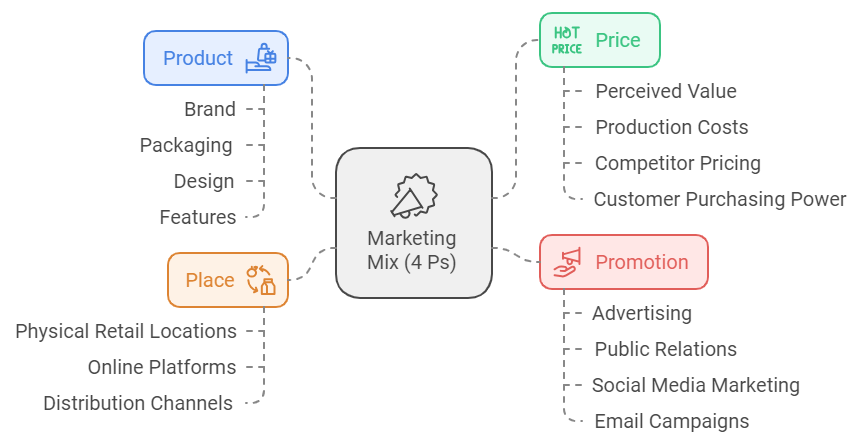Introduction:
A strategic marketing plan is a comprehensive blueprint that outlines an organization’s long-term marketing goals and the specific actions needed to achieve them. Unlike ad-hoc or short-term marketing efforts, a strategic marketing plan is designed to align marketing activities with the overall business strategy, ensuring that every marketing decision supports broader organizational objectives.
The importance of a strategic marketing plan lies in its ability to guide businesses through an increasingly competitive and dynamic market. By establishing clear objectives, understanding the target audience, and optimizing resources, businesses can focus their efforts on areas with the highest potential for growth. This proactive approach not only maximizes return on investment (ROI) but also allows for adaptability to changes in the market landscape.
In contrast to regular marketing, which may focus on immediate sales, promotions, or campaigns, a strategic marketing plan is forward-thinking. It anticipates future challenges, leverages opportunities, and provides a structured path to long-term success, helping businesses build sustainable competitive advantages. A well-crafted plan ensures that every marketing initiative, from branding to customer engagement, is part of a cohesive strategy aimed at fulfilling the company’s vision.
Set Clear Marketing Objectives

Setting clear marketing objectives is the cornerstone of any strategic marketing plan. These objectives provide direction and focus for your marketing efforts, ensuring that every action is purposeful and contributes to the overall success of the business. The most effective way to establish these goals is by using the SMART framework—goals that are Specific, Measurable, Achievable, Relevant, and Time-bound.
- Specific: Clearly define what you want to achieve. Vague goals like “increase brand awareness” can be hard to track and measure. Instead, a specific goal could be “increase social media followers by 20%.”
- Measurable: Ensure that your objectives can be quantified. By setting measurable targets, such as generating 500 new leads per quarter, you create a way to track progress and determine success.
- Achievable: Goals must be realistic based on the current resources and market conditions. Setting overly ambitious objectives can lead to frustration and wasted resources. Aim for targets that challenge your team but are still within reach.
- Relevant: Your marketing objectives should directly support your overall business strategy. For example, if your business is focused on expanding into new geographic regions, then your marketing objectives should align with increasing brand visibility and engagement in those areas.
- Time-bound: Every goal should have a clear deadline. Whether it’s increasing website traffic by 15% in the next six months or launching a new product campaign by the end of the year, timelines keep your team accountable and ensure steady progress.
SMART goals serve as the foundation for all marketing activities, providing a structured path forward and enabling your team to measure success along the way. By aligning these objectives with the broader business strategy, a strategic marketing plan ensures that marketing efforts contribute directly to overall company growth, helping to meet both short- and long-term goals.
Conduct a SWOT Analysis

A SWOT analysis—an evaluation of Strengths, Weaknesses, Opportunities, and Threats—is a vital tool in developing a robust strategic marketing plan. It provides a clear view of both internal and external factors that can influence your business’s marketing efforts. By systematically assessing these areas, businesses can craft strategies that leverage their strengths, mitigate weaknesses, capitalize on opportunities, and address potential threats.
- Strengths: These are internal factors that give your business a competitive edge. For example, a strong brand reputation, a loyal customer base, or proprietary technology. Understanding these strengths helps you emphasize them in your marketing strategy. If your strength is innovative product development, for instance, you might focus your messaging on this unique advantage to attract more customers.
- Weaknesses: Internal factors that may limit your business’s ability to succeed. These could include limited financial resources, lack of brand awareness, or gaps in your product lineup. Identifying weaknesses is crucial because it allows you to address them proactively. For example, if brand recognition is low, your marketing plan may need to include more focused brand-building campaigns.
- Opportunities: These are external factors that your business can exploit to its advantage. Market trends, emerging technologies, or gaps in competitors’ offerings can present growth opportunities. For example, if consumer demand is shifting toward eco-friendly products and your company offers sustainable options, you could focus on this in your marketing to attract environmentally-conscious customers.
- Threats: External challenges that could negatively impact your business. These could include economic downturns, increased competition, or regulatory changes. Recognizing threats allows you to develop contingency plans. If new competitors are entering your market, your marketing efforts may need to differentiate your brand more clearly or emphasize customer loyalty programs to retain existing customers.
By conducting a SWOT analysis, businesses gain a comprehensive understanding of where they stand and how they can position themselves more effectively in the marketplace. This analysis informs marketing decisions, from brand messaging and product positioning to target audience selection and promotional strategies. A well-executed SWOT analysis ensures that your strategic marketing plan is both realistic and adaptable to market conditions, allowing your business to maximize opportunities and mitigate risks.
Develop the Marketing Mix (4 Ps)

The marketing mix, commonly referred to as the 4 Ps—Product, Price, Place, and Promotion—is a foundational model in shaping a strategic marketing plan. Each element plays a critical role in how a business delivers value to its customers and meets market demands. Tailoring the 4 Ps to align with your marketing objectives ensures that your product or service not only meets customer needs but also achieves a competitive advantage in the market.
- Product: The product refers to the goods or services your business offers. It’s essential that your product meets the needs and desires of your target audience. This involves not just the physical item or service itself, but also the brand, packaging, design, and features. For example, if your target market values innovation, your product development should focus on offering cutting-edge technology or unique features that differentiate it from competitors. A key part of a strategic marketing plan is determining how to position your product in a way that resonates with your audience.
- Price: Pricing strategy is a critical element of the marketing mix. It must reflect the product’s perceived value while also considering factors like production costs, competitor pricing, and customer purchasing power. For instance, a premium product might be priced higher to convey superior quality, while a cost-sensitive market might require competitive pricing to attract customers. Your pricing strategy should align with your business goals—whether that’s maximizing profit margins or capturing market share.
- Place: Place refers to how and where your product is distributed and made available to customers. This could involve physical retail locations, online platforms, or distribution channels like wholesalers. Ensuring that your product is easily accessible to your target audience is crucial. For example, if your audience prefers shopping online, investing in e-commerce platforms and optimizing online distribution is key. The strategic choice of distribution channels ensures that your product reaches customers in the right place, at the right time.
- Promotion: Promotion encompasses all the activities that communicate your product’s value and benefits to your target audience. This includes advertising, public relations, social media marketing, email campaigns, and more. Effective promotion strategies ensure that your product stands out in a crowded market. Tailoring your promotional efforts based on the preferences of your audience—whether it’s through digital channels for a tech-savvy crowd or traditional media for a more mature demographic—will maximize the impact of your marketing.
Each element of the 4 Ps is interconnected, and they must be aligned to support your overall strategic marketing plan. For example, if you’re positioning a high-end product (Product) with a premium price (Price), you’ll need to distribute it in exclusive retail locations (Place) and promote it using luxury-focused advertising channels (Promotion). Customizing the marketing mix in response to market conditions and customer needs ensures that your marketing efforts are cohesive, effective, and aligned with your business objectives.
A well-tailored marketing mix allows businesses to deliver the right product, at the right price, through the right channels, with the right promotional strategies—ultimately ensuring the success of the strategic marketing plan.
Measure and Optimize Performance
Tracking and analyzing performance is a crucial component of any strategic marketing plan. By monitoring key performance indicators (KPIs), businesses can measure the effectiveness of their marketing activities and determine whether they are on track to meet their objectives. KPIs can include metrics such as website traffic, conversion rates, customer acquisition cost (CAC), return on investment (ROI), and social media engagement. Each KPI provides valuable insights into how different elements of your marketing strategy are performing.
Regularly reviewing the plan’s performance is essential to identify what is working and what needs adjustment. This data-driven approach allows businesses to make informed decisions about reallocating resources, adjusting tactics, or even revising objectives if necessary. For example, if a digital advertising campaign is not generating the expected leads, it might be time to revisit the target audience or tweak the messaging. Continuous monitoring ensures that you can address issues in real-time, preventing wasted efforts and lost opportunities.
The ability to optimize performance over time is a key benefit of tracking KPIs. By analyzing past results, businesses can refine their strategies to improve efficiency and effectiveness, thereby maximizing ROI. Whether it’s optimizing a landing page to increase conversions or adjusting a pricing strategy to better align with customer behavior, continuous improvement ensures that your strategic marketing plan remains relevant and impactful.
Moreover, optimizing performance allows businesses to stay agile in a rapidly changing market environment. Consumer preferences, competitive landscapes, and technological advancements evolve quickly, and the most successful businesses are those that adapt their strategies accordingly. Regular performance reviews ensure that your marketing efforts are flexible, enabling you to pivot as needed and stay ahead of industry trends.
Conclusion
In summary, the five essential steps to creating a strategic marketing plan—setting clear marketing objectives, understanding your target audience, conducting a SWOT analysis, developing the marketing mix, and measuring and optimizing performance—are key to building a roadmap for long-term success. Each step plays a critical role in ensuring that your marketing efforts are both purposeful and aligned with your business goals.
A well-executed strategic marketing plan does more than guide day-to-day marketing activities; it connects those efforts to the broader vision of the organization, driving both sustainable growth and a lasting competitive advantage. By regularly reviewing performance and adapting to market changes, businesses can ensure their strategy remains relevant and effective, allowing them to thrive in a dynamic and competitive environment. Ultimately, this plan becomes a powerful tool that not only helps businesses meet their objectives but also positions them for continued success in the future.

Juan is a Digital Advertising / SEM Specialist with over 10 years of experience with Google AdWords, Bing Ad Center, Facebook, LinkedIn, Google Analytics, HTML, and WordPress. He is a co-founder of Sheaf Media Group and has work in several online advertising projects for retail, automotive, and service industries. Additionally, Juan holds a bachelor’s degree in Psychology and has a deep interest in the science of human behavior which he attributes as the key factor for his success in the advertising world.


